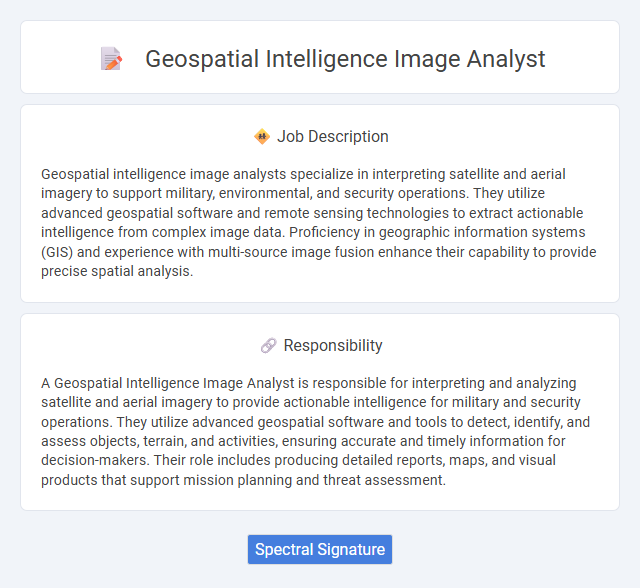
Geospatial intelligence image analysts specialize in interpreting satellite and aerial imagery to support military, environmental, and security operations. They utilize advanced geospatial software and remote sensing technologies to extract actionable intelligence from complex image data. Proficiency in geographic information systems (GIS) and experience with multi-source image fusion enhance their capability to provide precise spatial analysis.
Individuals with strong analytical skills and attention to detail are likely to be well-suited for a Geospatial Intelligence Image Analyst position. Those who thrive in fast-paced, high-pressure environments and possess a capacity for interpreting complex imagery and spatial data may find this role both challenging and rewarding. People with a resilient mindset and ability to work independently or within a team might have a higher probability of success in this field.
Qualification
A Geospatial Intelligence (GEOINT) Image Analyst requires a strong background in geographic information systems (GIS), remote sensing, and satellite imagery interpretation. Proficiency in software tools like ArcGIS, ENVI, and SOCET GXP is essential, along with analytical skills to assess spatial data for defense or intelligence purposes. A bachelor's degree in geography, geospatial science, or a related field, often supplemented by security clearance and experience in military or intelligence environments, is typically required.
Responsibility
A Geospatial Intelligence Image Analyst is responsible for interpreting and analyzing satellite and aerial imagery to provide actionable intelligence for military and security operations. They utilize advanced geospatial software and tools to detect, identify, and assess objects, terrain, and activities, ensuring accurate and timely information for decision-makers. Their role includes producing detailed reports, maps, and visual products that support mission planning and threat assessment.
Benefit
A Geospatial Intelligence Image Analyst job likely offers significant benefits such as the opportunity to work with cutting-edge geographic information systems and satellite imagery, enhancing analytical skills in a high-demand field. Candidates may benefit from competitive salaries, comprehensive training programs, and access to advanced technological tools that improve career growth prospects. The role probably provides valuable experience contributing to national security or disaster management, leading to diverse professional opportunities.
Challenge
Geospatial intelligence image analyst roles likely present challenges related to interpreting complex satellite and aerial imagery under tight deadlines, requiring high attention to detail and advanced analytical skills. Analysts may frequently encounter ambiguous or incomplete data, which increases the probability of needing iterative analysis and collaboration with experts from multiple disciplines. The rapidly evolving technology and growing data volumes probably demand continuous learning and adaptability to maintain accuracy and effectiveness in intelligence assessments.
Career Advancement
Geospatial intelligence image analysts develop expertise in satellite and aerial imagery to support national security and defense missions. Career advancement often involves mastering advanced geospatial technologies, acquiring certifications such as the Certified Geospatial Analyst (CGA), and gaining experience in intelligence analysis and interpretation. Opportunities for progression include roles like Senior Analyst, Team Lead, and Geospatial Intelligence Officer, with potential transitions into strategic intelligence, technology development, or policy advisory positions.
Key Terms
Spectral Signature
A Geospatial Intelligence Image Analyst specializes in interpreting spectral signatures to identify materials, vegetation, and land features from satellite or aerial imagery. Proficiency in analyzing multispectral and hyperspectral data enables precise classification and monitoring of terrain changes, aiding in defense, resource management, and environmental assessment. Mastery of spectral signature extraction enhances situational awareness by revealing hidden patterns invisible to the naked eye.
 kuljobs.com
kuljobs.com